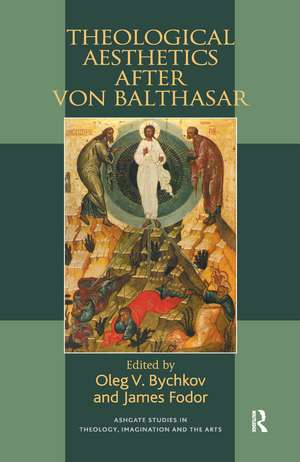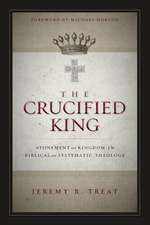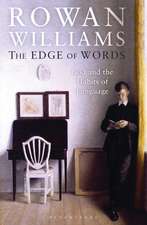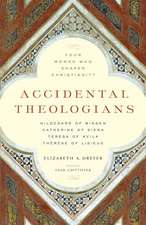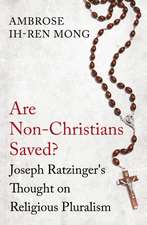Theological Aesthetics after von Balthasar: Routledge Studies in Theology, Imagination and the Arts
Autor Stan Hawkins Editat de James Fodor, Oleg V. Bychkoven Limba Engleză Paperback – 19 oct 2016
| Toate formatele și edițiile | Preț | Express |
|---|---|---|
| Paperback (1) | 449.41 lei 6-8 săpt. | |
| Taylor & Francis – 19 oct 2016 | 449.41 lei 6-8 săpt. | |
| Hardback (1) | 1054.71 lei 6-8 săpt. | |
| Taylor & Francis – 28 iun 2008 | 1054.71 lei 6-8 săpt. |
Din seria Routledge Studies in Theology, Imagination and the Arts
-
 Preț: 369.52 lei
Preț: 369.52 lei -
 Preț: 326.26 lei
Preț: 326.26 lei - 9%
 Preț: 934.73 lei
Preț: 934.73 lei -
 Preț: 309.75 lei
Preț: 309.75 lei - 17%
 Preț: 257.08 lei
Preț: 257.08 lei -
 Preț: 389.66 lei
Preț: 389.66 lei -
 Preț: 388.52 lei
Preț: 388.52 lei - 13%
 Preț: 321.56 lei
Preț: 321.56 lei -
 Preț: 388.52 lei
Preț: 388.52 lei -
 Preț: 386.99 lei
Preț: 386.99 lei -
 Preț: 489.26 lei
Preț: 489.26 lei -
 Preț: 489.26 lei
Preț: 489.26 lei -
 Preț: 389.66 lei
Preț: 389.66 lei -
 Preț: 466.29 lei
Preț: 466.29 lei -
 Preț: 391.39 lei
Preț: 391.39 lei -
 Preț: 436.14 lei
Preț: 436.14 lei -
 Preț: 389.66 lei
Preț: 389.66 lei -
 Preț: 386.18 lei
Preț: 386.18 lei -
 Preț: 389.20 lei
Preț: 389.20 lei -
 Preț: 389.66 lei
Preț: 389.66 lei - 9%
 Preț: 901.30 lei
Preț: 901.30 lei -
 Preț: 296.64 lei
Preț: 296.64 lei
Preț: 449.41 lei
Nou
Puncte Express: 674
Preț estimativ în valută:
86.02€ • 89.46$ • 72.08£
86.02€ • 89.46$ • 72.08£
Carte tipărită la comandă
Livrare economică 14-28 martie
Preluare comenzi: 021 569.72.76
Specificații
ISBN-13: 9781138259584
ISBN-10: 1138259586
Pagini: 272
Dimensiuni: 156 x 234 x 15 mm
Greutate: 0.45 kg
Ediția:1
Editura: Taylor & Francis
Colecția Routledge
Seria Routledge Studies in Theology, Imagination and the Arts
Locul publicării:Oxford, United Kingdom
ISBN-10: 1138259586
Pagini: 272
Dimensiuni: 156 x 234 x 15 mm
Greutate: 0.45 kg
Ediția:1
Editura: Taylor & Francis
Colecția Routledge
Seria Routledge Studies in Theology, Imagination and the Arts
Locul publicării:Oxford, United Kingdom
Cuprins
Contents: Introduction, Oleg Bychkov; Part I The Legacy of von Balthasar: Section A The Trilogy: Hans Urs von Balthasar: beauty as a gateway to love, Francesca Aran Murphy; Hans Urs von Balthasar's 'Theatre of the World': the aesthetics of a dramatics, Ben Quash; Section B. Retrieving the Past: Transcending the aesthetic: Gadamer on tragedy and the tragic, Daniel L. Tate; The beautiful after Thomas Aquinas: questioning present-day concepts, Günther Pöltner; Divine delight: acceptatio and the economy of salvation in Duns Scotus, Mary Beth Ingham; Hopkins, Scotus and von Balthasar: philosophical theology in poetry, Bernadette Waterman Ward. Part II Von Balthasar: Some Criticisms: Balthasar, Hopkins and the 'English tradition', Fergus Kerr; Von Balthasar and Protestant aesthetics: a mutually corrective conversation, Lee Barrett; Is the time right for a theological aesthetics?, George Pattison. Part III Outside von Balthasar: the Spectrum of Theological Aesthetics: Section A General Perspectives: Beyond beauty and the aesthetic in the engagement of religion and art, Nicholas Wolterstorff; The beauty of the Cross, Richard Viladesau; Is good art good for religion?, Frank Burch Brown; On a new list of aesthetic categories, Alejandro Garcia-Rivera; Section B Specific Issues: 'Alien beauty': parabolic judgment and the witness of faith, James Fodor; The strange and the self: visual arts and theology in Aboriginal and other (post-) colonial spaces, Sigurd Bergmann; Aesthetics and the built environment, Timothy Gorringe; Index.
Notă biografică
Oleg V. Bychkov and James Fodor are both Associate Professors in the Department of Theology at St. Bonaventure University, USA.
Recenzii
’The text is certainly profitable for the specialist interested in theological aesthetics and reflects the variety, even confusion, that is present within the discipline today... a welcome addition to the field.’ American Theology Inquiry
Descriere
This collection of essays by distinguished authors explores the present-day field of theological aesthetics: from von Balthasar’s contribution and parallel developments to correctives and alternatives to his approach. A tribute to von Balthasar’s own project expands into a dialogue with ancient and medieval traditions in search of revelatory aesthetics. The contributors outline challenges to his approach (including Protestant perspectives) and introduce new ways of viewing the field of theological aesthetics, which ultimately opens up to the idea of concrete cultural contexts and practical human needs determining the use of the arts and aesthetic sensibilities in theology.
